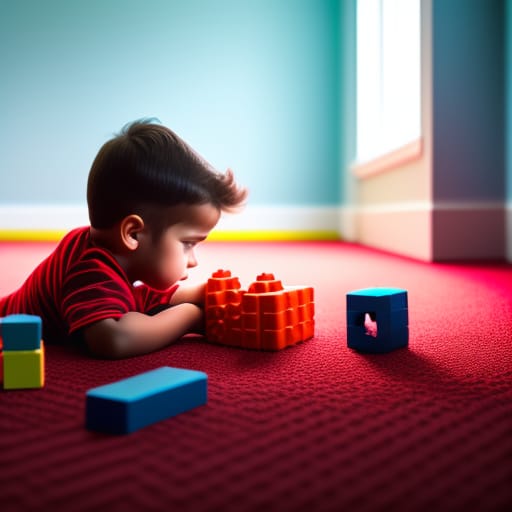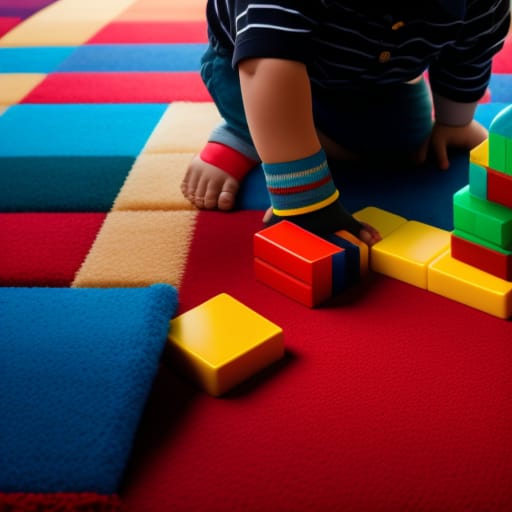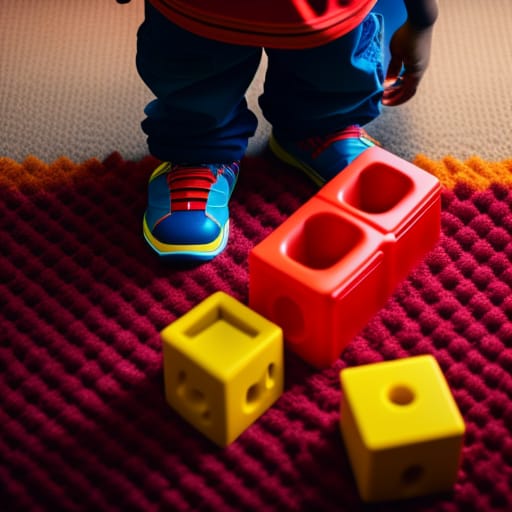Plastic building blocks are a classic toy that has inspired creativity and imagination in children for over 60 years. These simple, modular construction toys made of plastic have become a staple in bedrooms, classrooms, and playrooms around the world.
In this beginner’s guide, we’ll explore the history, manufacturing, and benefits of plastic building blocks. You’ll learn about the most popular types, like the iconic cuboid-shaped blocks from LEGO, as well as newer building systems made from sustainable materials.
Whether you’re looking for an educational toy to help develop your child’s skills, a fun STEM toy to spark their interest in science and engineering, or simply a good old-fashioned toy to let their creativity run wild, plastic building blocks have a lot to offer. Let’s dive in!

A Brief History of Building Blocks
Building blocks have been around in some form since ancient civilizations, but plastic interlocking blocks as we know them today trace their origins to the mid-20th century.
In 1949, the LEGO Group in Denmark began producing automatic binding bricks made of cellulose acetate, an early thermoplastic. These early plastic blocks allowed for better form-fit assembly than traditional wooden blocks thanks to patented interlocking studs and tubes.
LEGO started using modern acrylonitrile butadiene styrene (ABS) plastic in 1963. ABS offered improved elasticity and dimensional stability for a tight clamping effect.
Over the next few decades, LEGO released iconic sets like LEGO DUPLO for younger builders in 1969 and LEGO CITY in 1978. The LEGO SYSTEM OF PLAY launched in 1977 allowed pieces from different sets to interlock seamlessly, enabling unlimited creativity and variability.
Since then, LEGO has become by far the largest plastic building block manufacturer in the world. However many other companies have produced similar building toys over the decades, with more emphasis on education or sustainability.
The popularity of plastic building blocks continues today, both as a fun kid’s toy for free play and an educational toy for developing critical skills.
Types of Plastic Building Blocks
There is a diverse array of plastic building blocks available today, but they fall into a few main categories:
Cuboid-Shaped Building Blocks
The classic cuboid bricks made famous by LEGO are one of the most iconic plastic building blocks. They come in a range of colors and sizes, typically snapped together by studs and tubes. The cuboid shape and modular system allow for sturdy construction and unlimited possibilities.
Basic Building Blocks
These larger, chunkier blocks in simple geometric shapes make construction easy for younger builders. Brands like Mega Bloks and Duplo (LEGO’s version) offer good starter sets.
Classic Building Bricks
Vintage-looking sets like K’Nex’s Lincoln Logs, Tinkertoys, and wood-textured blocks evoke nostalgia while still being fun to play with. These make good open-ended gift sets.
Alphabet/Number Blocks
Blocks engraved with letters, numbers, and symbols help kids learn basics while building. Some also have Braille for developing literacy.
Metallic Building Sets
Several companies like SuperKids make building sets with magnetic brass-, silver-, or steel-coated blocks. These allow for unique construction like jewelry, sculptures, and interactive toys.
How Plastic Building Blocks Are Manufactured
The most common material for plastic building blocks is acrylonitrile butadiene styrene (ABS), a durable thermoplastic polymer. Here is a quick overview of the manufacturing process:
- Injection molding: Molten ABS plastic is injected into a mold under high pressure then rapidly cooled, creating solid ABS in the shape of a brick.
- Ejection: The finished bricks are ejected from the mold by ejector pins.
- Trimming: Excess plastic is trimmed off the bricks with revolving blades.
- Testing: Dimensions, clutch power, and durability are tested against strict quality standards.
- Printing: Decals, patterns, or numbers are printed onto the bricks as needed.
- Packaging: Bricks are bagged up or packaged into sets.
ABS is used for its durability, grip, and ability to stick to itself (cohesiveness) while still being detachable. The special formulation provides just the right tensile strength and elasticity for bricks to hold together securely while not being too stiff.
High-precision molds and automation produce plastic bricks with very tight dimensional tolerances for consistent clutch power and perfect interlocking ability. This innovative manufacturing process allows the mass production of plastic building blocks around the world.
Plastic building blocks are manufactured using an intricate injection molding process that produces precise, durable bricks.
Why Plastic Building Blocks Are So Popular
Plastic building blocks have captivated children and adults for over half a century now. What makes them such an enduring, beloved toy?
Endless Creativity & Imagination
The modular, interlocking design means the possibilities are truly endless when it comes to what you can build. From simple houses and towers to intricate castles, spaceships, or even functioning machines, plastic building blocks put creativity and engineering into the builder’s hands.
Parents love seeing their kids use imagination and problem-solving to build exciting worlds and stories from simple colored bricks.
Teach Educational Concepts
Building sets designed around topics like architecture, technology, ecology, etc. have proven educational value. Following visual instructions to recreate models introduces important STEM skills. Making your unique creations requires planning, spatial reasoning skills, and an understanding of basic physics.
Many preschools and elementary schools use building blocks to teach subjects like math, science, and literacy in a hands-on way. Their versatility also encourages important skills like creativity, critical thinking, and collaboration.
Develop Motor Skills & Hand-Eye Coordination
The process of hunting for the right bricks, putting them together, and pulling them apart again helps develop fine motor skills and hand-eye coordination in young kids. Physically manipulating the pieces builds strength in small hand muscles that will later be used for writing, drawing, and other tasks.
Fun for All Ages
Adults often reminisce fondly about the hours of fun they had playing with building blocks as children. Entire generations have grown up with plastic building blocks as a staple toy in their playrooms.
Even as adults, many people still enjoy building block sets as a relaxing hobby or even for displaying impressive sculptures. Building blocks truly offer ageless fun and nostalgia.
Fuel Interest in STEM Subjects
Since building blocks are essentially a child-friendly introduction to engineering and design concepts, they can spark lifelong interest in technical and creative fields.
Younger kids get a sense of accomplishment from constructing simple structures. Older kids can explore more complex mechanical engineering and architectural principles while having fun. This hands-on experience translating ideas into 3D models provides excellent motivation to pursue science, technology, engineering, and math.
Plastic building blocks engage kids’ natural creativity while teaching STEM principles through play.

Educational Benefits of Building Blocks
Beyond being fun toys, plastic building blocks offer many developmental benefits for children. Here are some of the key ways they support learning:
Promote problem-solving & critical thinking
To build intricate structures, kids need to visualize shapes and patterns, and then problem-solve to make them physically work using spatial reasoning and engineering concepts.
Encourage creativity & self-expression
With no strict rules, building sets allow kids to construct anything they can imagine. This open-ended play fosters creativity, communication, and confidence.
Teach cause & effect relationships
As kids assemble pieces, they learn about structural stability, balance, and the laws of physics. They see how block placement impacts the result.
Reinforce STEM & math concepts
Modular systems introduce foundational geometry, fractions, and arithmetic. Following step-by-step builds teaches planning, patterning, and logical sequencing skills.
Develop fine motor control & dexterity
Snapping together tiny bricks takes concentration, nimble fingers, pincer grasps, and bilateral coordination. These enhance future handwriting ability.
Strengthen hand-eye coordination
Locating, grasping, rotating, and joining blocks in different orientations hones visuomotor skills for manipulating objects.
Encourage focus & concentration
Block play requires sustained attention to detail to assemble structures correctly. This builds focus that aids in learning.
Building toys like LEGOs nurtures children’s minds through creative, engaging play.
Beyond classroom-based learning, independent playtime with building blocks allows kids to hone skills at their own pace by following interests and challenging themselves. The open-ended possibilities make for an ideal self-directed learning tool.
Environmental Sustainability
With plastic waste becoming an urgent issue, some companies are developing more eco-friendly materials for building blocks. Two examples are:
ByBlocks uses recycled milk jugs to make soft, brick-like blocks that easily stick together using proprietary connectors. The blocks are fully recyclable and biodegradable.
bioMASON grows durable bricks through a process similar to coral by combining sand with microorganisms. The bricks don’t require firing, emitting far less carbon. LEGO is even piloting bioMASON bricks made of stone dust as a greener alternative to ABS plastic.
Many plastic block brands like Mega Bloks now use plant-based plastics from sources like sugar cane rather than oil. While not currently recyclable due to colors and additives, they have a smaller carbon footprint.
Eco-friendly materials are allowing the classic appeal of building blocks to continue responsibly.
Recommended Building Block Sets for Kids
Here are some top-rated plastic building block sets to consider for kids of different ages:
Preschoolers
- LEGO DUPLO – Classic brick sets with bigger pieces for little hands. $15-$60
- Mega Bloks First Builder Sets – Themed starter sets to spark the imagination. $15-$30
- Melissa & Doug Chunky Puzzle Blocks – Colorful wooden blocks with puzzles on the sides. $18
Early Elementary
- LEGO Classic Bricks – Foundational sets for open-ended building. $20-$60
- KidKraft Building Brick Set – 100-piece set with storage. $20
- PicassoTiles 3D Magnetic Building Tiles – Colorful magnetic tiles for making 3D sculptures. $25
Tweens
- LEGO Creator 3-in-1 Sets – Mid-size sets with 3 models in one. $20-$100
- GEOSTIX Construction Set – Flexible rods and connectors for creative engineering. $35
- K’Nex Education Intro to Structures – Bridge and skyscraper-themed sets. $50
Building block sets tailored to different age groups balance challenge and creativity.
Choosing developmentally appropriate sets ensures an engaging, frustration-free builder experience. Look for sets with enough complexity to be stimulating but not overwhelming. Read customer reviews to assess quality and play value.
Using Building Blocks in Education
Beyond being toys, building blocks have become a versatile education tool used from preschool through university.
Teaching Communication, Collaboration, and Creativity
Teachers often use blocks in early childhood settings to help develop social skills. Students must share materials and take turns. They practice communication, cooperation, and problem-solving to build something together.
Block play also provides a canvas for individual creativity and self-expression. Rather than following instructions, teachers can have students build something unique from their imagination.
Enhancing STEM Education
Building block challenges can illustrate STEM concepts in an applied, hands-on manner. Students might need to build a structure that can withstand “earthquake” vibrations, teach angles through geometric patterns, or apply ratios/proportions to scale up a model.
Architecture and design classes also utilize building kits to explore materials, forces, and 3D modeling principles. The immediate feedback helps concepts stick.
Building Block Workshops
Some innovative libraries and community centers have hosted building block programs for learners of all ages to enhance creativity and community connections.
For example, at North Carolina State University, the library offers LEGO® SERIOUS PLAY® workshops as a safe, judgment-free way for students to engage in reflection and discuss complex issues through metaphorical block building.
Hands-on building experiences create memorable learning moments applicable to real-world problems.
Educators should continue finding creative ways to incorporate building blocks across disciplines. The benefits for engagement, collaboration, and tangible learning are immense for all ages.
The Future of Building Blocks
Plastic building blocks have come a long way while retaining many of their core benefits since their inception. Where might the future of building toys go next?
Some possibilities include:
- Virtual reality integration – Building in 3D virtual spaces or controlling constructs with VR gloves
- Robotics sets – Seamlessly blending building bricks with motorized parts and programming
- Advanced physics – Sets with more advanced mechanical or architectural features
- Sustainable materials – New production and recycling processes to be more eco-friendly
- Customizability – Printing your unique bricks or textures
- Adaptability – Bricks or connectors that flex or shift to allow movement after construction
However they evolve, building blocks will surely continue to be a staple toy for encouraging open-ended play and STEM learning. The simple joy of assembling creations out of modular parts persists across generations.

The Enduring Popularity of Building Blocks
For over half a century, humble plastic building blocks have instilled creativity and joy in generations of children. With endless possible constructions, they encourage imaginative play and problem-solving. As an educational toy, they also help develop fine motor skills, spatial reasoning, and early STEM skills that prepare youth for the future.
While new manufacturing methods and materials are making blocks more environmentally sustainable, their engaging play value remains timeless. The hands-on, screen-free experience of building a structure piece-by-piece, and then watching your vision come to life is immensely satisfying.
From future architects and engineers to those who simply cherish the nostalgic fun, plastic building blocks will continue inspiring people of all ages to build, learn, and explore new worlds out of small plastic bricks.
Frequently Asked Questions About Plastic Building Blocks
What are the most popular brands of plastic building blocks?
The most well-known brand is LEGO, which offers a huge variety of classic block sets, themed kits, and more advanced Technic sets. Other popular brands are Mega Bloks, People Blocks, Magformers, PicassoTiles, and Magna-Tiles.
How do I choose good STEM toys for my kids?
Look for open-ended construction toys like blocks that allow kids to build, take apart, and rebuild endless creations. Building sets that focus on architecture, engineering, robotics, or physics are great for learning STEM concepts while playing.
Should I get alphabet blocks for my preschooler?
Yes, letter blocks can help young kids learn phonics and pre-literacy skills. Building simple words sharpens phonemic awareness. Try getting blocks with letters on one side and pictures starting with that letter sound on the other.
What’s the best way to clean plastic building blocks?
Use a mild soap and water solution with a small brush to scrub each block. Avoid harsh cleaners which can damage the plastic. Air dry completely before use. For a deep clean, consider using a diluted hydrogen peroxide soak.
How can I use building blocks as educational toys in preschool?
Free build time allows imagination and problem-solving. You can also guide builds around themes, letters, numbers, colors, or book characters. Add creative challenges like building the tallest tower with a set number of blocks.
Can I recycle old or used plastic building blocks?
If marked with recycling codes 2, 4, or 5, they can go in your curbside recycling (but check local rules). Contact the manufacturer about any mail-back programs too. Unfortunately, most don’t get recycled due to sorting limitations.
Are there STEM learning benefits for playing with blocks as an adult?
Absolutely! Adult hobbyists build intricate sculptures, mechanisms, and models. Following complex designs without instructions exercises spatial reasoning, engineering thinking, and problem-solving. The creative outlet can also reduce stress.